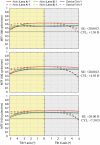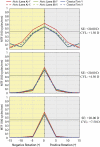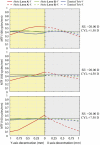Effect of decentration, tilt and rotation on the optical quality of various toric intraocular lens designs: a numerical and experimental study
- PMID: 35519245
- PMCID: PMC9045935
- DOI: 10.1364/BOE.447045
Effect of decentration, tilt and rotation on the optical quality of various toric intraocular lens designs: a numerical and experimental study
Abstract
Toric intraocular lenses (T-IOLs) may lose their optical quality if they are not correctly positioned inside the capsular bag once implanted. In this work, T-IOLs with cylinder powers of +1.50, +4.50 and +7.50 D and differing degrees of spherical aberration have been designed, manufactured and tested in vitro using a commercial optical bench that complies with the requirements of standard ISO 11979-2. Moreover, the effect of tilt and rotation on optical quality was assessed by means of numerical ray tracing on an astigmatic eye model, while the effect of decentration was evaluated numerically and experimentally.
© 2022 Optica Publishing Group under the terms of the Optica Open Access Publishing Agreement.
Conflict of interest statement
The authors declare no conflicts of interest.
Figures








Similar articles
-
Optical Quality Variation of Different Intraocular Lens Designs in a Model Eye: Lens Placed Correctly and in an Upside-Down Position.Ophthalmic Res. 2023;66(1):757-766. doi: 10.1159/000528504. Epub 2023 Jan 30. Ophthalmic Res. 2023. PMID: 36716717
-
Evaluation of optical performance of 4 aspheric toric intraocular lenses using an optical bench system: Influence of pupil size, decentration, and rotation.J Cataract Refract Surg. 2015 Oct;41(10):2274-82. doi: 10.1016/j.jcrs.2015.10.059. J Cataract Refract Surg. 2015. PMID: 26703305
-
Optical performance of toric intraocular lenses in the presence of decentration.Int J Ophthalmol. 2015 Aug 18;8(4):730-5. doi: 10.3980/j.issn.2222-3959.2015.04.16. eCollection 2015. Int J Ophthalmol. 2015. PMID: 26309871 Free PMC article.
-
Effect of Intraocular Lens Tilt and Decentration on Visual Acuity, Dysphotopsia and Wavefront Aberrations.Vision (Basel). 2020 Sep 14;4(3):41. doi: 10.3390/vision4030041. Vision (Basel). 2020. PMID: 32937750 Free PMC article. Review.
-
Tilt and decentration with various intraocular lenses: A narrative review.World J Clin Cases. 2022 Apr 26;10(12):3639-3646. doi: 10.12998/wjcc.v10.i12.3639. World J Clin Cases. 2022. PMID: 35647149 Free PMC article. Review.
Cited by
-
The influence of rotational error and axial shift of toric intraocular lenses on residual astigmatism.PLoS One. 2024 Dec 5;19(12):e0311566. doi: 10.1371/journal.pone.0311566. eCollection 2024. PLoS One. 2024. PMID: 39636844 Free PMC article.
-
Effect of Decentration, Rotation, and Tilt on Objective Optical Quality of Plate Haptic Toric Intraocular Lenses in the Early Postoperative Period.Transl Vis Sci Technol. 2024 Feb 1;13(2):19. doi: 10.1167/tvst.13.2.19. Transl Vis Sci Technol. 2024. PMID: 38407885 Free PMC article.
-
Evaluation of the mechanical stability of intraocular lenses using digital image correlation.Sci Rep. 2023 Jun 9;13(1):9437. doi: 10.1038/s41598-023-36694-0. Sci Rep. 2023. PMID: 37296225 Free PMC article.
References
-
- Poler S., “Intraocular lens with astigmatism correction,” U.S. patent, 4,277,852A (21 January 1981).
-
- Lieberman D.M., “Method of offsetting postoperative astigmatism with an intraocular lens,” U.S. patent, 4,512,039A (24 May 1985).
LinkOut - more resources
Full Text Sources
